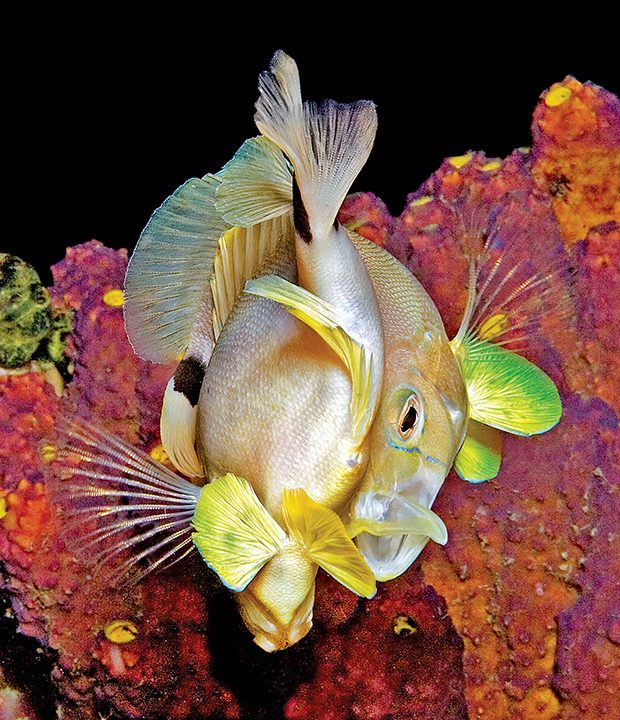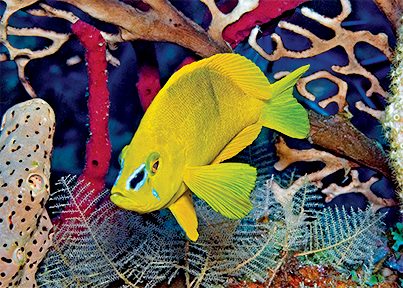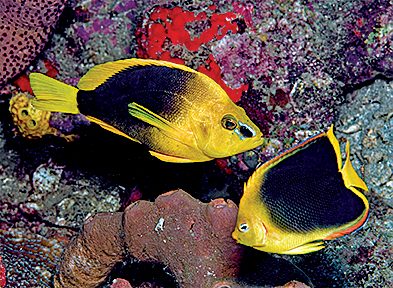Menjadi atau tidak menjadi spesies
SEJAK AKHIR 1800-ANperdebatan di antara para ahli taksonomi kelautan telah berputar-putar di sekitar status spesies ikan bass laut Karibia kecil yang megah dalam genus Hypoplectrusyang umumnya dikenal sebagai dusun. Inti dari kontroversi ini adalah esensi dari taksonomi: Apa yang mendefinisikan sebuah spesies?
The most common interpretation of species relates to individuals capable of mating with one another to produce fertile offspring. The hamlet intrigue revolves around the group’s similar breeding habits and almost complete lack of anatomical differences. Yet, for an unexplained reason, hamlets across the Caribbean display a variety of distinct color patterns.

Menambahkan lebih banyak lagi bumbu pada sup dusun adalah hamparan variasi dari perkawinan silang yang relatif tinggi antara morf warna, yang memunculkan hibrida, menengah dalam warna dan tanda dari induknya.
Typically, the offspring of different species in the same genus are sterile, but hamlet hybrids are fertile — an anomaly some researchers have used as evidence against granting separate species status to members of the genus. Over the years they have described the hamlet flock as varieties, types, color morphs, morphotypes morphospecies, and subspecies.
Using evidence available from aquarium breeding and the discovery of low genetic differences among species from the same geographical regions, however, today’s taxonomists uneasily lean toward granting species status to at least 18 distinct and regularly occurring color morphs.
Of more interest to the typical underwater naturalists is the hamlets’ impassioned courtship and spawning behaviors that take place each evening during the fading glow of twilight. Throughout the day the palm-sized loners poke around for crabs, shrimp, and recently settled larval fishes inside the craggy confines of their limited home ranges. As the sun sets, they slip out of their comfortable surroundings and wind their way through hostile terrain for nightly trysts with established partners at traditional spawning sites.
Seperti beberapa keluarga ikan karang yang terkenal, ikan hias adalah hermaprodit simultan, yang berarti mereka jantan dan betina pada saat yang sama. Alih-alih terus-menerus berebut posisi, ikan dusun bergiliran melepaskan telur dan sperma beberapa kali dengan pasangan yang sudah lama ada. Strategi reproduksi egaliter ini jarang terjadi, hanya terjadi pada 40 dari 34.000 spesies ikan.


As soon as a pair of starry-eyed hamlets rendezvous, the reef’s most accessible, predictable, and entertaining reproductive spectacle begins. For up to an hour before the first spawn, pairs playfully chase and feed near the bottom while watching for predators and rivals keen on breaking up the evening’s lovefest.
Saat masa pacaran berakhir, salah satu dari pasangan ini mengambil peran sebagai betina. Berperan sebagai perayu, ia berpose moncong tegak dengan sirip mengembang dan kepala yang tersentak, sementara si jantan sementara, yang warnanya sangat pucat, bergerak di dasar laut. Dusun-dusun itu naik secara terpisah ke kolom air, biasanya di atas gundukan karang atau semak gorgonian tempat si penampil menampilkan dirinya.
In a blink the fish clasp, like encircling hands. The acting male — with his head down, belly puckered, fins spread, and mouth opened — is enveloped by the arching body of his mate. After a few seconds the fish pop apart, leaving behind an inconspicuous cloud of gametes. The pair alternately play out the clasps, ranging from two to 10 or more, until the last light fades.
An equal number of egg releases between partners is sacrosanct. From dozens of spawning events we’ve observed, the clasp count ended on an odd number only twice. Both incidents incited nipping chases by the wronged party.
Apa yang mendorong diversifikasi dusun? Pendapat bervariasi di antara para peneliti, namun konsensus umum adalah bahwa genus Hypoplectrus mungkin belum berevolusi sampai setelah penutupan Tanah Genting Panama sekitar 2,8 juta tahun yang lalu. Tanggal tersebut mungkin terlihat kuno, namun dalam skala waktu evolusi, dusun adalah anak baru di blok ini dan masih terus berkembang.
And then there is the suggestion that the rise and fall of sea levels segregated the color morphs. Further muddling the matter is the hypothesis that the mimicking of nonpredatory fishes drives the hamlets’ various color patterns.
Dan apa sebenarnya spesies itu? Pertanyaan klasik ini juga masih belum terjawab, bahkan setelah para pemikir besar dalam biologi merenungkannya sejak awal ilmu evolusi.
Following the discovery of astounding differences in every genus of barnacles he studied, Charles Darwin wrote from his study at Down House: “After describing a set of forms as distinct species, tearing up my MS., and making them one species, tearing that up and making them separate, and then making them one again, I have gnashed my teeth, cursed species, and asked what sin I had committed to be so punished.” AD
© Penyelam Siaga - Q3 2023